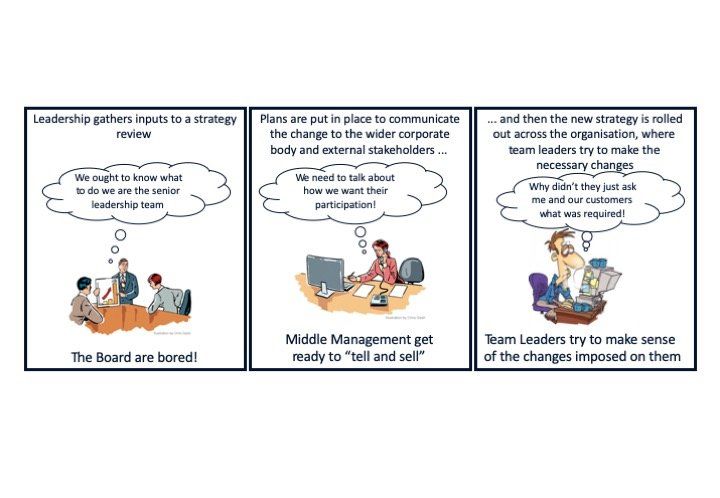A New Transformation Prism
- by Paul Kelly
- •
- 19 Dec, 2019
A New Transformation Prism

Why do so many business transformations fail?
This article explores a new approach to sustainable transformation.
By Vikki Kirby, Paul Kelly and Ian Barratt
According to Gartner[1], 96% of all companies are in some form of organisational transformation. Yet less than one in three of these planned change programmes is successful. They fail to achieve their performance objectives or deliver sustained improvements. Even worse, McKinsey reports 74% are only partly or not at all successful.
We wanted to know what makes transformation stick.
We have experience of working with over a hundred public and private sector organisations and have found the typical approach to change is linear, one-directional and non-inclusive.
This might appear too simplistic. It assumes organisations perpetuate a top-down, patriarchal, machine-driven approach (a method that is reminiscent of the post-industrial revolution era). Sadly, that’s the kind of environment so many still endure. It leaves the organisation’s communities disempowered and its leaders isolated.
So, we offer a new direction. One that uses Storytelling and a Systemic Approach to develop Strategic Leadership. An approach that enables change to take place in a more organic, sustainable way.
This multi-disciplinary methodology reflects the way organisations need to rethinktheir approach to change. It recognises that we cannot continue to work in an analogue world. We just have to get used to that idea.
Instead, we need to apply more systemic, test-and-learn methods. A world-view that embraces agility and complexity. And an ethos that promotes the emotional connectivity organisations will need to thrive.
Successful organisations see themselves as systems working within a wider ecosystem. They recognise themselves as a combination of internal and external communities of stakeholders. In the same way that nature's ecosystems develop, they evolve to thrive in rapidly changing environments. They advance by being connected, co-operative and coherent, with a clear sense of purpose.
Typical characteristics[2] include having a north star - a clear and consistent core purpose. The ability to work through networks of small, empowered teams is vital, as is frequent calibration based on carefully tracked goals and metrics.
Crucially, while they use next-generation enabling technology, they always put peopleat their heart. Those internal and external communities of stakeholders are engaged with, listened to and given a voice. In turn, they become passionate advocates and help deliver change that sticks.
Using a combination of Strategic Thinking, a Systemic Approach and AppliedStorytelling, we believe organisations will be more successful at delivering sustainable change. By that we mean change that drives meaningful growth, is operationally realistic and gives people something to unite behind.
In other words, is successful.
The 3S Model
We have visualised our approach as a Prism with 3 facets - our 3S model. The approach involves those who will implement the change and those impacted by it.
Our 3S approach:
· Fosters a range of potential options represented by the many colours the Prismproduces from a single white light
· Applies perspectives from these three disciplines
· Helps to isolate the real challenges, and
· Provides a framework to identify and focus the optimal solution.
As a consequence of involving people, communication and engagement are not just an output. From the start, we ensure that stories are in the room. Stories help make sense of complexity and can shape strategy. We use them to challenge how credibility, authenticity and objectivity will be achieved.
This is a key component of what we mean by Strategic Leadership. Organisations and their ecosystems are complex enough. Simplifying that complexity and finding ways for stakeholders to engage is critical.
What we do
The conventional approach to change is further impacted by management’s desire to fit information into a preconceived idea of reality, with resultant bias.
The Prism encourages leaders to embrace a diversity of views. It helps them move towards a new, more relevant, reality. This goes beyond ‘strategy as a document'. It's about discovering that north star and developing authentic Strategic Leadership.
It's about moving into a world that Simon Sinek articulates as the ‘Why'? A world where “people follow leaders who follow something bigger than themselves”.
We help leaders navigate the cultural dynamics of their organisation. This starts with asking the right questions: Why does the organisation exist? Is it doing things in the right way? What is the hardest thing to do first?
Answering fundamental questions like these uncovers different perspectives and enriches understanding. Rather than blurring the picture, it helps to bring things into focus.
In making sense of what is often complex, we are able to find the most important core qualities that set that organisation apart in their sector or marketplace. In other words, its distinctive purpose.
It’s a process of Discovery, Design and Delivery
What is: Working together, we help clients engage stakeholders, to understand and to see the situation from different perspectives. Result: A more holistic picture enriched by diversity.
What could be: We help them to decide by developing focused solutions and creating the “new story”. Result: Solutions are desirable, viable and sustainable.
What will be: Finally, we help them to act. To establish a programme and to plan and support its implementation. Here is where Storytelling can bring change to life, making it meaningful and inspiring.
Cultural storytellers say, "without our stories, we don't exist". They embrace opportunities to spread their stories far and wide, from generation to generation and through channels that resonate in their time. They keep them simple, explicit and commit them to memory. They assign cultural identity, a kind of branding, to augment the story.
It's the same within organisations. Without people who are prepared to strive for it, and customers or users who buy into it, they don't survive. Without a compelling purpose-driven vision at the core, they won't thrive.
And without a clearly expressed strategy and operational credibility wound around that core idea, the business story can’t be written.
Let’s have a conversation. To learn more about our unique 3S approach, contact us:
Vikki Kirby on 07794 278089
Paul Kelly on 07801 671741
Ian Barratt on 07747 027512
References:
[1] Gartner (2019) Shaping Culture to Support Organisational Transformation.
[2] McKinsey & Co. (2018) Leading agile transformation: The new capabilities leaders need to build 21st Century organisations.






